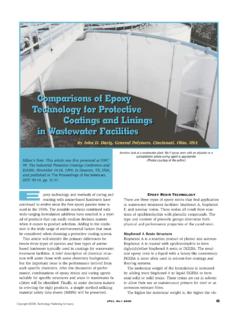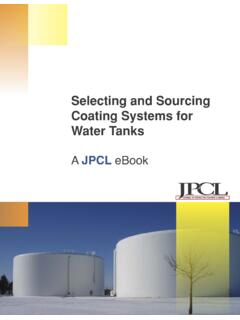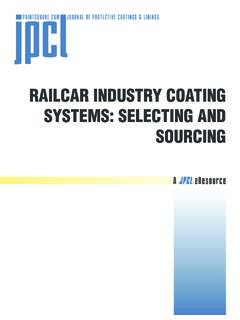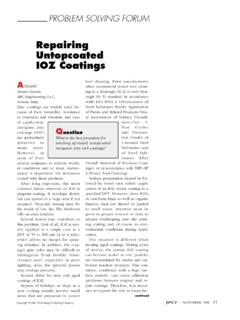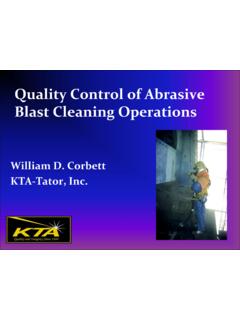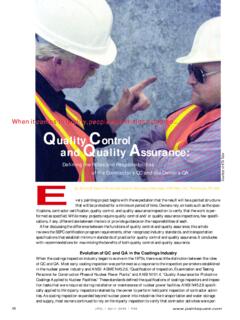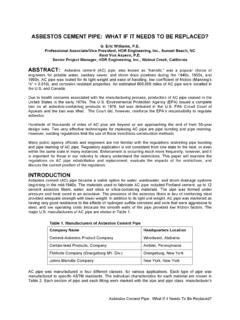Transcription of Ultra-High-Pressure Waterjetting jpcl
1 ultra - high -PressureWaterjettingA JPCL eBookCopyright 2012 byTechnology Publishing Company2100 Wharton Street, Suite 310 Pittsburgh, PA 15203 All Rights ReservedThis eBook may not be copied or redistributed without the written permission of the Use of Ultra-High-Pressure Waterjetting by Lloyd SmithSSPC Visual Standards Update 2003: A Picture is Worth a Thousand Wordsby Aim e Beggs and Michael DamianoThe Effects of UHP Waterjetting on Concrete Moisture Levelsby Todd A. ShawverEquipment Maintenance: Getting ultra - high Performance from your UHP Hoseby Paul Webster and Stephen JohnsEquipment Maintenance: Don t Let the pressure Get You Down: Maintaining UHP Systemsby Rick SchmidProblem Solving Forum: On Water Quality for UHP Water JettingJPCL,with respondents Rick Schmid, Rich Burgess, Lydia Frenzel, and John TannerHow Does Waterjet Cleaning Affect the Surface and Surface Preparation?
2 By Lydia FrenzelCharacterizing Surfaces after UHP Waterjetting in New Ship Constructionby Phillippe Le Calve, et Coatings Perform over Waterjetting in New Constructionby Phillippe Le Calve, et BY1iv514182224263339ivIntroductionIntrod uctionThis eBook consists of JPCL articles on Ultra-High-Pressure Waterjetting ,and is designed to provide general guidance on the use and maintenance of the associated water jetting (UHP WJ) is defined by SSPC and NACE as cleaningwith water pressures above 1,700 bar (25,000 psi)1and is defined in ISO 8501-4 asabove 1,400 bar (21,000 psi). While these high pressures can be effective for cleaning,they are also dangerous. This ATB will concentrate on using UHP WJ equipment focus on the safe use of UHP WJ should not be interpreted to mean that lower wa-ter pressures are safe.
3 Any time pressurized water is used, the operator should receive training inthe proper equipment operation and personal protective BasicsUHP WJ systems consist of a high - pressure pump, hoses, and various tools. The hydraulic hosesused must have a bursting strength times the maximum-rated operating capacity. Therefore, a1,700 bar (25,000 psi) unit requires hoses with a minimum bursting strength of 4,250 bar (62,500psi). The tools used in field surface preparation consist of a control valve, lance (wand), and nozzleassembly. In manually operated systems, this nozzle is usually referred to as the jetting gun. Thecontrol valve is operated by a trigger, which is protected by a trigger guard. The lance is a sectionof metal pipe that allows the operator to point the nozzle assembly at the surface.
4 The nozzle as-sembly contains the jets, which are orifices or tips that have very small openings. Tools can have asingle jet, a fan-shaped jet, or multiple rotating jets. The most common arrangement on UHP WJequipment for cleaning steel is a rotating multiple jet assembly. A single jet has a very small blastpattern. Multiple jets on a rotating head increase the size of the blast pattern to increase produc-tivity. Rotation also increases the cutting UHP WJ, the pressure , , velocity, of the water is the main energy characteristic that per-forms the cleaning. This is different from high - pressure water jetting (HP WJ) units that operate be-tween 700 and 1,700 bar (10,000 and 25,000 psi) where flow rate plays a role equal to water ve-locity in cleaning.
5 pressure falls off quickly with distance. Productive cleaning with UHP WJrequires keeping the nozzle 6 to 13 mm ( to in.) from the surface. HP WJ units, where flowrate contributes to cleaning, are normally held 5 to 25 cm (2 to 10 in.) from the surface. UHP WJrequires closer stand-off distance, yet is, however, especially dangerous at close distances. The clos-er you are to the surface, the closer the wand end is to your body and the more you are at risk fromthe HazardsWater pressure of 1,700 bar (25,000 psi) is extremely powerful and dangerous. The main safetyhazards associated with UHP WJ are injection and fatigue. UHP WJ can cut skin and bones at close distances, , the distance used to clean surfaces. Air in-jection equipment used to give vaccinations operates at about 40 bar (600 psi).
6 UHP WJ units usepressures about 20 to 40 times higher. So a water jet striking you from several centimeters can eas-ily penetrate the skin. If this happens, you may not see the full extent of the injury. The entrywound may be quite small and may not bleed. But there is no telling how much water was injectedinto the body or if any internal damage was done. Micro-organisms can enter through the woundand spread inside the body. Safety1By Lloyd SmithEditor s note: This article appearedin JPCLin November Use of Ultra-High-Pressure WaterjettingUIf an accident occurs that penetrates the skin, medical attention should be obtained it is not possible to have the injury treated immediately, restrict first aid to dressing the woundand observing the person until a medical examination can be performed.
7 The injury should be mon-itored by a physician for several days to make sure that infection does not possibility in addition to injection is that skin or flesh can be removed. This takes lessthan seconds if the wand is swept past an unprotected body associated safety hazard is a hose rupture. Experience has shown that 90 to 95% of hose rup-tures occur 15 to 25 cm (5 to 10 in.) from the connection to the lance. A hit from a water jet at closedistance to the abdomen or neck can be fatal. Special hose protection that is attached to the hosenear the lance is available to protect against being hit by these types of hose is another problem associated with water jetting. This results from the back thrust of theequipment. Back thrust can be calculated from the equation:Back thrust (lb) = x Q x P1/2 where:Q = flow rate ( )P = jet pressure (psi)For example, an operator working with a jet at 30,000 psi (2,000 bar) and using 6 (23 l/m)will experience a force equal to 54 lb (24 kg), calculated as thrust = x 6 (30,000 psi)1/2= x 6 x 173= 54 lb (24 kg)It is recommended that a person not be required to withstand a back thrust of more than one-third of his body weight.
8 Fatigue can happen in minutes or less, depending on the worker. There-fore, the operator for this example should weigh at least 162 lb ( kg).Safety EquipmentProper personal protective equipment should be worn when using UHP WJ equipment. This in-cludes head, eye, body, foot, hand, hearing and respiratory protection should be worn at all times. The head protection should include a full face protection is also needed. The use of a face shield and/or eye protection such as goggles is high -ly recommended for visibility. Water droplets forming on goggles or face shields may be a nuisance,but it is still easier to see through wet goggles than it is when you get water directly in your addition, material removed from the surface, such as pieces of coatings, can get into the eyes ifthey are not clothing must be worn to protect the body.
9 The garment should completely cover theoperator, including the arms and legs (Fig. 1). Regular work clothes will quickly become saturatedwith water. The protective clothing should have an outer layer that repels rebounding water andprovides protection from rebounding debris that may be a hazard to the operator. Most typical wetsuits worn by operators will not stop penetration of the waterjet into the skin if the nozzle gets tooclose to the body. Body armour is recommended for the operator. This special UHP WJ protectiveclothing is made from high -strength materials such as Dyneema (Dutch State Mines) or Kevlar (DuPont). They can take the sweep of the jet at a distance of 5 cm (3 in.) and up to 3,000 bar (45,000psi) without rupturing.
10 The time that the nozzle is directed at the material is also important. Thefaster that the nozzle is swept over the surface, the less the chance for are especially susceptible to inadvertent exposure to the water jets at close distance if theoperator should point the lance down without shutting off the equipment. Waterproof boots withsteel toe caps should be worn by everyone on the job. The operator should also wear a metatarsalguard atop the boots (Fig. 2) . [Editor s note: the metatarsal guard protects the part of the foot thatforms the instep and includes the five bones between the toes and ankle, called the metatarsus.]2 Fig. 1: Water jetter with protective suit and hoseprotection on high - pressure water of TST Sweden ABHands should be protected with plastic-coated or rubber gloves.

